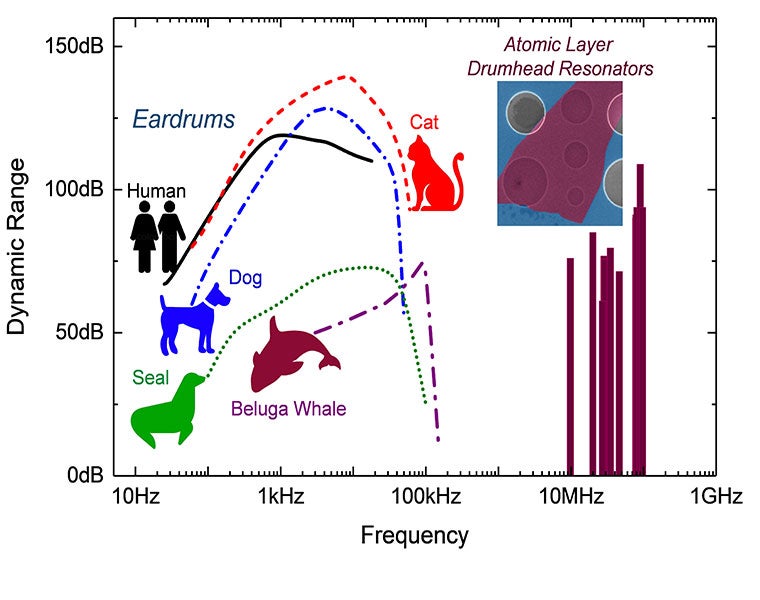Case Western Reserve University researchers make dynamic advances with new atomically thin device
Researchers at Case Western Reserve University are developing atomically thin “drumheads” able to receive and transmit signals across a radio frequency range far greater than what we can hear with the human ear. But the drumhead is tens of trillions times (10 followed by 12 zeros) smaller in volume and 100,000 times thinner than the human eardrum. The advances will likely contribute to making the next generation of ultralow-power communications and sensory devices smaller and with greater detection and tuning ranges. “Sensing and communication are key to a connected world,” said Philip Feng, an associate professor of electrical engineering and computer science and corresponding author on a paper about the work published March 30 in the journal Science Advances. “In recent decades, we have been connected with highly miniaturized devices and systems, and we have been pursuing ever-shrinking sizes for those devices.” Comparison of dynamic ranges and frequency bands of the eardrums of humans, other animals, and atomically thin drumheads.
The challenge with miniaturization: Also achieving a broader dynamic range of detection, for small signals, such as sound, vibration, and radio waves.
“In the end, we need transducers that can handle signals without losing or compromising information at both the ‘signal ceiling’ (the highest level of an undistorted signal) and the ‘noise floor’ (the lowest detectable level),” Feng said.
While this work was not geared toward specific devices currently on the market, researchers said, it was focused on measurements, limits and scaling which would be important for essentially all transducers.
Those transducers may be developed over the next decade, but for now, Feng and his team have already demonstrated the capability of their key components—the atomic layer drumheads or resonators—at the smallest scale yet.
The work represents the highest reported dynamic range for vibrating transducers of their type. To date, that range had only been attained by much larger transducers operating at much lower frequencies—like the human eardrum, for example.
“What we’ve done here is to show that some ultimately miniaturized, atomically thin electromechanical drumhead resonators can offer remarkably broad dynamic range, up to ~110dB, at radio frequencies (RF) up to over 120MHz,” Feng said. “These dynamic ranges at RF are comparable to the broad dynamic range of human hearing capability in the audio bands.”
Comparison of dynamic ranges and frequency bands of the eardrums of humans, other animals, and atomically thin drumheads.
The challenge with miniaturization: Also achieving a broader dynamic range of detection, for small signals, such as sound, vibration, and radio waves.
“In the end, we need transducers that can handle signals without losing or compromising information at both the ‘signal ceiling’ (the highest level of an undistorted signal) and the ‘noise floor’ (the lowest detectable level),” Feng said.
While this work was not geared toward specific devices currently on the market, researchers said, it was focused on measurements, limits and scaling which would be important for essentially all transducers.
Those transducers may be developed over the next decade, but for now, Feng and his team have already demonstrated the capability of their key components—the atomic layer drumheads or resonators—at the smallest scale yet.
The work represents the highest reported dynamic range for vibrating transducers of their type. To date, that range had only been attained by much larger transducers operating at much lower frequencies—like the human eardrum, for example.
“What we’ve done here is to show that some ultimately miniaturized, atomically thin electromechanical drumhead resonators can offer remarkably broad dynamic range, up to ~110dB, at radio frequencies (RF) up to over 120MHz,” Feng said. “These dynamic ranges at RF are comparable to the broad dynamic range of human hearing capability in the audio bands.”





